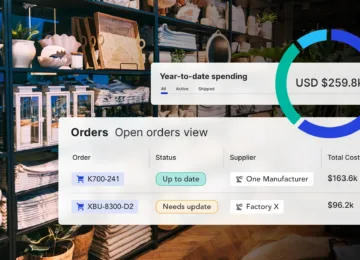As a business, you understand that supply chain management is a key element in getting raw materials, making goods, and delivering new products to the end user. Having control over your supply chain helps you manage unpredictable demand and other procurement issues in order to meet your order fulfillment goals. Having control of your supply chain depends on supply chain modeling, and once you have a plan in place, you can improve customer satisfaction and upend the traditional supply chain process.
But what exactly is supply chain modeling? How does it improve end efficiency and responsiveness in your organization, and give you an advantage in different competitive markets? In this article, we’ll evaluate the six supply chain models to help you leverage the best supply chain model for your business.
What Is Supply Chain Modeling?
Supply chain modeling is an attempt to bring order to the general chaos of a supply chain to achieve specific business objectives. It can include everything from supply chain invoicing to warehousing to the distribution of finished products. When you have a supply chain model, you can use the process to plan and optimize the supply chain routes your business needs to succeed.
Without supply chain modeling, your processes wouldn’t be optimized to the level they need to be. Modeling is like having a well-oiled machine, and it can be used to help improve the logistics in your supply chain. Supply chain modeling helps you deliver a perfect product with on-time delivery and friendly service while effectively resolving any issues in the supply chain.
What Are the Benefits of Supply Chain Modeling?
There are many different benefits that supply chain modeling can bring to businesses. Having a supply chain model helps you control your inventory and know where it is at all times. It also helps you reduce your overall costs and overhead by giving you a bird’s-eye view of your supply chain. You can also increase the efficiency of your processes and respond to customer demand quicker in order to improve customer satisfaction.
To achieve these benefits, your supply chain model needs to be robust — and needs to be the right fit for your business. There are different types of models that will work well in different industries, so you need to make sure that you implement the best option for your organization. When you have the proper supply chain model for your business, you can gain a competitive advantage over others in your industry who don’t have the same processes and optimization strategies in place.
Supply chain models address many different questions and considerations, including:
- What should be produced?
- What market identification do you have?
- What areas of your supply chain should be audited?
- How do you choose the best site for your production plants?
- How can you find the best suppliers?
- Where are your suppliers and plants located?
- What are the best methods of transportation and inventory?
- How should you go about distributing finished products?
- Which warehousing strategies can help you grow?
What Are the 6 Supply Chain Models?
There are six main types of supply chain models that you can use in your organization. Let’s dive into them to give you the context you need to choose the best fit based on your business needs and your supply chain strategy goals.
1. The Continuous Flow Model
The continuous flow model is made for industries and manufacturing businesses that need to deliver continuously. When there is a continued, steady stream of products and resources going out to the customers, you need a supply chain that can meet those demands. This is best for established brands with strong supply chain networks and minimal variation between purchase orders. For example, Coca-Cola has a large customer base with little to no variety in the demand, even with changing seasons and markets.
Pros and Cons
- Good for established commodity businesses
- Bad for new businesses or small businesses that have changing demand
2. The Agile Model
The agile model requires the business to have four key components: virtual integration, process alignment, market sensitivity, and a network base. These elements work together to help a business find trends and quickly put together products that fit into the current market demand and customer need trends. It works well for brands that need to create custom products but also need to have core products, like specialty clothing companies such as ZARA.
Pros and Cons
- Good for businesses that need to quickly adapt to new trends
- Bad for businesses that have a high demand for the same products
3. The Fast Chain Model
The fast chain model is used by businesses that have products with a short lifespan, which need to be delivered frequently and may be considered trendy. This model helps businesses that need to change the types of products they send frequently and deliver to market before the product loses relevance. This might include clothing companies or sporting goods companies like Adidas, who need to get their products on the shelves before trends change.
Pros and Cons
- Good for apparel and trendy brands
- Bad for businesses that have established demand
4. The Efficient Chain Model
The next model is the efficient chain model which, as the name suggests, focuses on supply chain efficiency. It works for businesses that have highly competitive markets and that need to be highly efficient within their supply chain logistics. This model prioritizes inventory management and delivery of goods by making sure that all equipment and machines are working optimally to produce goods without any unnecessary waste. For example, General Mills sells products similar to its competitors and has a thin profit margin, making efficiency a key goal for manufacturing.
Pros and Cons
- Good for businesses that need to increase efficiency in the manufacturing process
- Bad for businesses that have custom products and goods that take time to make
5. The Flexible Model
The flexible model is a type of supply chain model built to accommodate peaks and dips in customer demand over the year. These models need to have part segmentation, accurate stocking algorithms, and flexible planning in order to work. This is apparent in companies like Office Depot, which have seasonal increases in demand during the fall for back-to-school shopping. This model helps the company predict upcoming demand and stock up inventory as needed for these shifts in demand.
Pros and Cons
- Good for businesses that experience seasonal peaks in demand
- Bad for businesses that have a steady demand
6. The Custom-Configured Model
The final model is the custom-configured model, which can be considered a combination of the agile model and the continuous flow model. This model works best when there is a need for multiple product configurations during the production or assembly of different goods within the factory. This can help customers get the products they need quickly while allowing them to customize the product as needed. A great example of a company that benefits from this process is L.L. Bean, a clothing manufacturer that has options for custom stitching and other customization options on items like backpacks and polo shirts.
Pros and Cons
- Good for businesses that offer custom goods
- Bad for businesses with a high demand for similar products
Efficiency vs. Responsive Supply Chain Models
Certain supply chain models are built for efficiency, and others are made to be responsive. There’s no right or wrong answer about which will work for you, but you should be aware of where the above models fall into the two approaches so you can figure out which is best for your organization.
Some of the best and strongest supply chain models will incorporate elements of both responsive and efficient models for the best results. Both categories focus on keeping costs down, reducing risks, making customers happy, and enhancing your supply chain’s productivity across the board. When you can combine the two strategies, you can integrate your supply chain models and elevate your entire business when it comes time for growth.
Efficiency Supply Chain Models
Supply chain models that fit into the efficiency category are made to reduce lead times and focus on the commodity that the manufacturer is making — and get that to the lowest cost possible. These models are made to improve speed and cut costs across the entire supply chain process. They focus on keeping things moving quickly and providing a clear and simple rhythm to the supply chain processes. However, efficiency models have a few negative points, like leading to excess inventory or increasing costs in other areas besides the product creation process.
Supply chain models that fit into the efficiency theory include:
- Efficient chain model
- Fast chain model
- Continuous flow model
Responsive Supply Chain Models
Responsive chain supply models focus on flexibility for industries rather than on cutting unnecessary steps and reducing all costs. These models are great for businesses that deal with a level of uncertainty and need to have flexible supply chain strategies for managing these situations. These models rely more heavily on human intervention and less so on automation, as the circumstances around them can change frequently.
The most significant drawback of responsive supply chain models is the risk of human error, as there is more human input in these models. This includes the concern that untrained or undertrained staff members might negatively affect these models with their errors.
Supply chain models that fit into the responsive theory include:
- Agile model
- Flexible model
- Custom-configured model
Empower Your Supply Chain With Anvyl
Improving your supply chain is essential to business growth and stability. Having a supply chain model helps you improve your manufacturing processes and improve forecast accuracy in order to lower costs and meet increasing customer demands. A strong supply chain strategy will help you develop an agile model that focuses on adaptability and automation to help you move forward with your organization.
Empowering your supply chain requires the help of digital tools. At Anvyl, we help organizations streamline production processes, provide a central source of truth for your order information, and manage supplier and retailer relations. If you want to optimize your supply chain process and get ahead of the competition, get a demo of Anvyl today and see what we can do for you.



